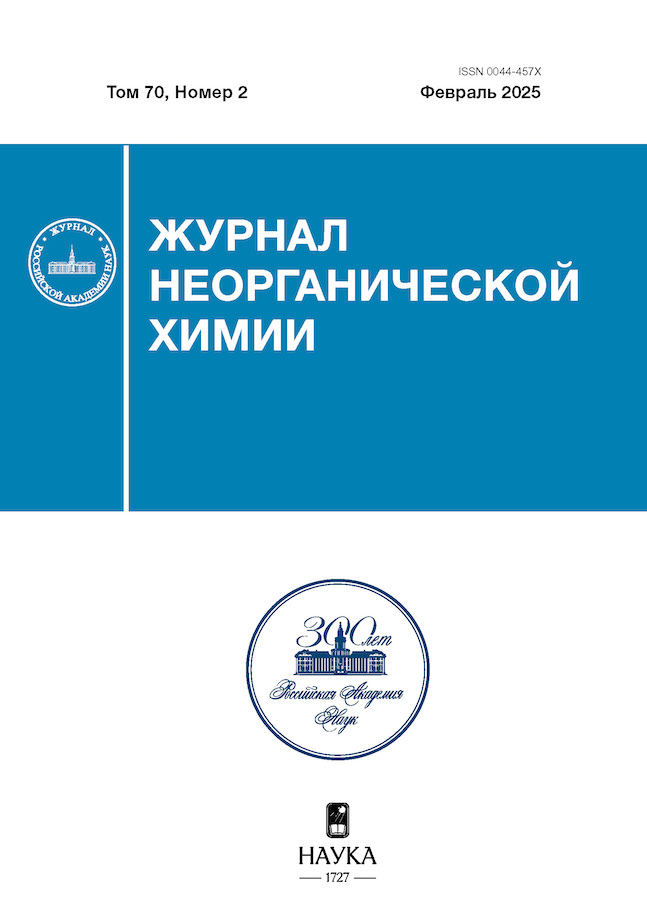Synthesis and physicochemical properties of magnesium complexes with 4Н pyran ligands
- 作者: Kozin S.V.1,2, Kravtsov A.A.1,2, Kindop V.K.1, Bespalov A.V.1, Ivaschenko L.I.1, Nazarenko M.A.1, Moiseev A.V.3, Churakov A.V.4, Vashurin A.S.4
-
隶属关系:
- Kuban State University
- Southern Scientific Center of the Russian Academy of Sciences
- Trubilin Kuban State Agrarian University
- Kurnakov Institute of General and Inorganic Chemistry of the Russian Academy of Sciences
- 期: 卷 70, 编号 2 (2025)
- 页面: 191-200
- 栏目: СИНТЕЗ И СВОЙСТВА НЕОРГАНИЧЕСКИХ СОЕДИНЕНИЙ
- URL: https://cijournal.ru/0044-457X/article/view/683197
- DOI: https://doi.org/10.31857/S0044457X25020065
- EDN: https://elibrary.ru/ICOVAX
- ID: 683197
如何引用文章
详细
As a result of the interaction of 4-oxo-4H-pyran-2,6-dicarboxylic (chelidonic) acid with magnesium acetate, a cocrystalline compound was obtained – magnesium chelidonate. The study of the process of thermo-oxidative destruction of magnesium chelidonate showed that its dehydration occurs in two stages, and the thermal destruction of the organic part is accompanied by pronounced thermal effects. In the structure of magnesium chelidonate, there is both an internal and an external coordination sphere around the magnesium cation. The internal sphere includes six water molecules, forming a magnesium hexaaqua cation. The external sphere is formed by anionic residues of chelidonic acid, linked by hydrogen bonds with water molecules of the internal coordination sphere of the magnesium cation. The structure of magnesium chelidonate crystallizes in the triclinic syngony of the space group and has an extensive network of hydrogen bonds between coordinated water molecules, acid anions and magnesium hexahydrate cations. Comparative analysis of the neuroprotective action of magnesium chelidonate and chelidonic acid showed that both compounds protected cultured neurons in a cellular ischemia model. This effect was expressed by a decrease in neuronal death during oxygen-glucose deprivation. At the same time, magnesium chelidonate was more effective than chelidonic acid at the same concentrations.
全文:
作者简介
S. Kozin
Kuban State University; Southern Scientific Center of the Russian Academy of Sciences
编辑信件的主要联系方式.
Email: kozinsv85@mail.ru
Laboratory of Problems of Distribution of Stable Isotopes in Living Systems
俄罗斯联邦, Krasnodar, 350040; Rostov-on-Don, 344006A. Kravtsov
Kuban State University; Southern Scientific Center of the Russian Academy of Sciences
Email: kozinsv85@mail.ru
Laboratory of Problems of Distribution of Stable Isotopes in Living Systems
俄罗斯联邦, Krasnodar, 350040; Rostov-on-Don, 344006V. Kindop
Kuban State University
Email: kozinsv85@mail.ru
俄罗斯联邦, Krasnodar, 350040
A. Bespalov
Kuban State University
Email: kozinsv85@mail.ru
俄罗斯联邦, Krasnodar, 350040
L. Ivaschenko
Kuban State University
Email: kozinsv85@mail.ru
俄罗斯联邦, Krasnodar, 350040
M. Nazarenko
Kuban State University
Email: kozinsv85@mail.ru
俄罗斯联邦, Krasnodar, 350040
A. Moiseev
Trubilin Kuban State Agrarian University
Email: kozinsv85@mail.ru
俄罗斯联邦, Krasnodar, 350044
A. Churakov
Kurnakov Institute of General and Inorganic Chemistry of the Russian Academy of Sciences
Email: kozinsv85@mail.ru
俄罗斯联邦, Moscow, 119991
A. Vashurin
Kurnakov Institute of General and Inorganic Chemistry of the Russian Academy of Sciences
Email: kozinsv85@mail.ru
俄罗斯联邦, Moscow, 119991
参考
- Walter a E.R.H., Hogg C., Parker D., Williams J.A. G. // Coord. Chem. Rev. 2021. V. 428. P. 213622. https://doi.org/10.1016/j.ccr.2020.213622
- de Baaij J.H., Hoenderop J.G., Bindels R.J. // Physiol.Rev. 2015. V. 95. P. 1. https://doi.org/10.1152/physrev.00012.2014. PMID: 25540137
- Louis J. M., Randis T. M. // JAMA. 2023. V. 330. P. 597. https://doi.org/10.1001/jama.2023.10673.
- Kim S. J., Kim D.S., Li Sh. et al. // Biol. Chem. 2023. V. 66. P. 12. https://doi.org/10.1186/s13765-022-00763-1
- Singh D.K., Gulati K., Ray A. // Int. Immunopharmacol. 2016. V. 40. P. 229. https://doi.org/10.1016/j.intimp.2016.08.009
- Oh H.A., Kim H.M., Jeong H.J. // Int. Immunopharmacol. 2011. V. 11. P. 39. https://doi.org/10.1016/j.intimp.2010.10.002
- Kim D.S., Kim S.J., Kim M.C. et al. // Biol. Pharm. Bull. 2012. V. 35. P. 666. https://doi.org/10.1248/bpb.35.666
- Avdeeva E., Porokhova E., Khlusov I. et al. // Pharmaceuticals. 2021. V. 146. P. 579. https://doi.org/10.3390/ph14060579
- Jeong H.J., Yang S.Y., Kim H.Y. et al. // Exp. Biol. Med. 2016. V. 241. P. 1559. https://doi.org/10.1177/1535370216642044
- Kozin S.V., Kravtsov A.A., Kravchenko S.V. et al. // Bull. Exp. Biol. Med. 2021. V. 171. P. 619. https://doi.org/10.1007/s10517-021-05281-6
- Rogachevskii I.V., Plakhova V.B., Penniyaynen V.A. et al. // Can. J. Physiol. Pharmacol. 2022. V. 100. P. 43. https://doi.org/10.1139/cjpp-2021-0286
- Kravtsov A.A., Shurygin A.Y., Skorokhod N.S., Khaspekov L.G. // Bull. Exp. Biol. Med. 2011. V. 150. P. 436. https://doi.org/10.1007/s10517-011-1162-x
- Shurygina L.V., Zlishcheva E.I, Kravtsov A.A., Kozin S.V. // Bull. Exp. Biol. Med. 2021. V.171. P. 338. https://doi.org/10.1007/s10517-021-05223-2
- Khan A., Park T.J., Ikram M. et al. // Mol. Neurobiol. 2021. V.58. P. 5127. https://doi.org/10.1007/s12035-021-02460-4
- Yasodha V., Govindarajan S., Low J.N., Glidewell C. // Acta Crystallogr C. 2007. V. 63. P. 207. https://doi.org/10.1107/S010827010701459X
- Ivashchenko L.I., Kozin S.V., Vasileva L.V. et al. // Russ. J. Coord. Chem. 2023. V. 49. P. 437. https://doi.org/10.31857/S0132344X22600412
- Case D.R., Gonzalez R., Zubieta J., Doyle R.P. // ACS Omega. 2021. V. 6. P. 29713. https://doi.org/10.1021/acsomega.1c04104
- Bannwarth C., Ehlert S., Grimme S. // J. Chem. Theory Comput. 2019. V. 15. P. 1652. https://doi.org/10.1021/acs.jctc.8b01176
- Pracht P., Grant D.F., Grimme S. // J. Chem. Theory Comput. 2020. V. 16. P. 7044. https://doi.org/10.1021/acs.jctc.0c00877
- Neese F. // WIREs Comput. Mol. Sci. 2011. V. 2. P. 73. https://doi.org/10.1002/wcms.81
- Neese F. // WIREs Comput. Mol. Sci. 2022. V. 12:c1606. P. 1. https://doi.org/10.1002/wcms.1606
- Kozin S., Kravtsov A., Ivashchenko L. et al. // Int. J. Mol. Sci. 2024. V. 25. P. 286. https://doi.org/10.3390/ijms25010286
- Kravtsov A., Kozin S., Basov A. et al. // Molecules. 2022. V. 27. P. 243. https://doi.org/10.3390/molecules27010243
- Malaganvi S.S., Tonannavar (Yenagi) J., Tonannavar J. // Heliyon. 2019. V. 5. P. 1. https://doi.org/10.1016/j.heliyon.2019.e01586
- Case D.R., Zubieta J., P Doyle R. // Molecules. 2020. V. 25. P. 3172. https://doi.org/10.3390/molecules25143172
- Khairnar S.I., Kulkarni Y.A., Singh K. // Rev Port Cardiol. 2024. V. 30. https://doi.org/10.1016/j.repc.2024.06.003.
补充文件













